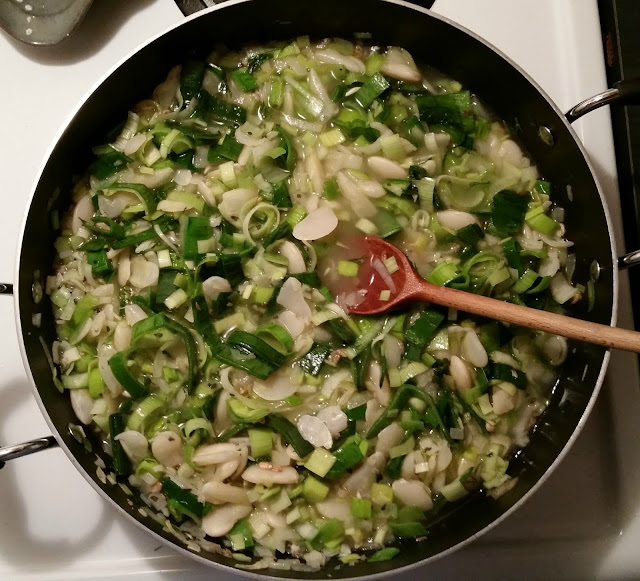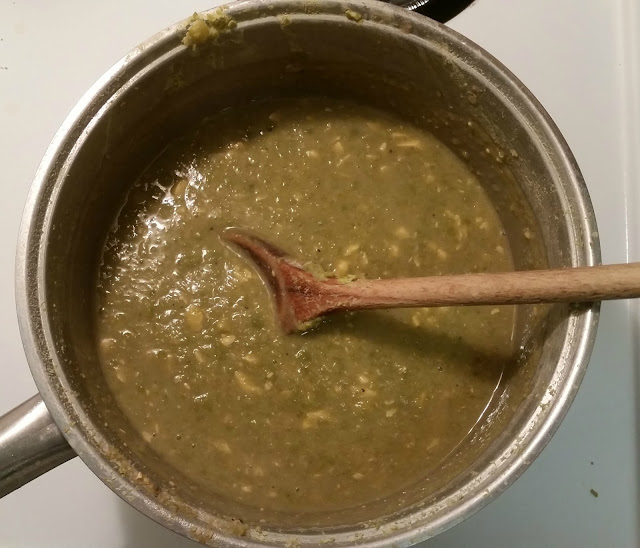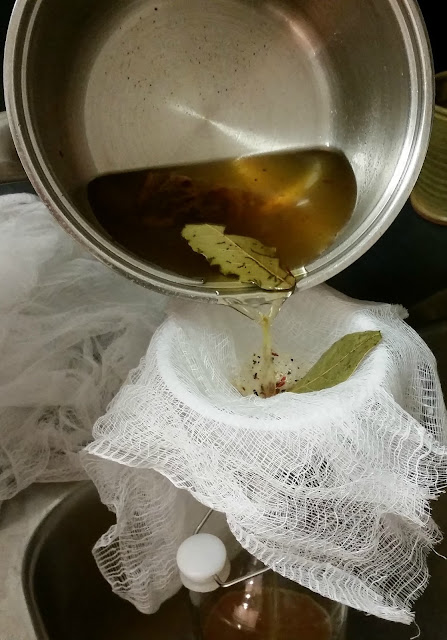BY: LEAH MONCADA
Selected Classical Recipes
Butter Beans in Herb Sauce- Roman Cookery
Lentil and Barley Soup - Roman Cookery
Vitellian Peas- The Classical Cookbook
Spiced Wine – The Classical Cookbook
For a full bibliography of the books used in the Classical Journey of Historic Kitchen, see this post.
Roman food historians perform a brave and perilous duty testing out ancient recipes. Without ingredient quantities, dishes have to be prepared countless times until they are 'gotten right'. Of course, at this point we still don't know (and barring the invention of a time machine, never will) if we have it correct, at the very least we can now eat it! However, to any who wish to pursue Roman cuisine, a cautionary word is found in Plautus:
“I don’t season a dinner the way the other cooks do. They serve you up whole meadows in their dishes- they treat guests like grazing cattle, shoving greens at them, then seasoning the greens with more greens. In go fresh coriander, fennel, garlic and alexanders, and on the side there’s sorrel, cabbage, beet and blite: they pour a pound of silphium into it, and smash mustard seed in on top: stuff so fierce it makes their own eyes water before they’re finished grinding it. When they cook a dinner they aren’t flavouring it with seasonings, but with night-owls that are going to eat out your living intestines! No wonder people around here die young when they pack up all this green stuff inside them, vegetables that are frightening even to talk about, let along eat. If the cows won’t eat it, you can be sure that people will!” -Plautus Pseudolus (1, 810)
The classical world ate a diet rich in vegetables. But where the Greeks ate fairly simple recipes, the Romans spared no effort (or expense) in the complexity of their greens or the variety of their spices. Grab your nose plugs, open the nearest window, have a ready glass of water, and get ready for some herbed herbs!
Butter Beans in Herb Sauce (Zomos) – Roman
Cookery, Mark Grant
From the Heidelberg Papyrus
 |
| Butter Beans in Herb Sauce. Looks like I fit the whole meadow in there. Photo: Leah Moncada |
175g dried butter beans
1 onion
2 tbsp olive oil
1 leek
60ml white wine
3 tbsp wheat flakes (which I could not find, substituted rye flakes)
1 tbsp fish sauce, or garum (for recipe, see this post)
a handful of coriander leaves
½ tsp dried dill tops
½ tsp dried basil
500ml water
1 tbsp white wine vinegar
a pinch aniseed
sea salt
a handful fresh parsley
Freezes well.
Soak the beans overnight, or until soft and split. Boil in salted water for 30 minutes. Fry the onion in olive oil until soft in a heavy casserole dish, then finely slice the leek and add it to the onion. Add the rest of the ingredients except the parsley. Bring to a boil and simmer on low heat for an hour, allowing the beans and wheat flakes to thicken the sauce. (I could not find wheat flakes, and tried to substitute rye, which underperformed in terms of thickening.) Sprinkle chopped parsley to taste just before serving.
I recommend keeping the room well ventilated while preparing this dish, and possibly investing in some anti-onion goggles. (Which, apparently, are a real thing.)
This is a very thick soup, perhaps more like a stew. Grant makes mention of how Roman soups likely were very thick as a standard, since utensils were not ubiquitously used as they are today. Manners would mean one refrained from sipping a bowl from the lips in company, so soups would have to be thick enough to be scooped with bread or other foods.
Lentil and Barley Soup (Phakoptisana) - Roman Cookery, Mark Grant
from Galen, quoted in Oribasius Medical Compilations
 |
| Lentil and Barley Soup. Delicious with last post's Pastry Balls! Photo: Leah Moncada |
60 g pearl barley
100g red lentils
1 leek
a bunch of fresh dill
a bunch of fresh savoury
sea salt to taste
Soak barley and lentils in water overnight. Chop and add together the leek, dill, and savoury. Add with the salt to the lentils and barley, cover, and simmer gently for one hour. Add more salt if necessary.
Soak barley and lentils in water overnight. Chop and add together the leek, dill, and savoury. Add with the salt to the lentils and barley, cover, and simmer gently for one hour. Add more salt if necessary.
Freezes well.
This is a very thick soup, perhaps more like a stew. Grant makes mention of how Roman soups likely were very thick as a standard, since utensils were not ubiquitously used as they are today. Manners would mean one refrained from sipping a bowl from the lips in company, so soups would have to be thick enough to be scooped with bread or other foods.
Vitellian Peas - The Classical Cookbook, Sally Grainger and Andrew Dalby
Apicius 5.3.5
 |
| Vitellian Peas. It tasted just about as good as it looked. Photo: Leah Moncada |
225g dried peas or 450g fresh (broad) fava beans
2cm fresh ginger root
1/2 tsp ground lovage seed
1/2 tsp ground black pepper
3 cooked egg yolks
3 tbsp clear honey
2 tbsp fish sauce, or garum (for recipe, see this post)
2/3 cup/150mL white wine
1/3 cup/80mL white wine vinegar
1 tbsp olive oil
Soak the peas overnight in cold water. Strain. Place in a pan and cover with fresh water. Bring to a boil, simmer for 1-1/2 hours until tender, adding extra water if necessary. Drain and beat or blend until smooth. (For fava beans, boil in salt water for 4-6 minutes until tender, drain and puree.)
With a pestle and mortar (and important set of tools in any classical kitchen!), grind the freshly peeled ginger with the lovage and pepper. Add the egg yolks and pound until it is a smooth paste. Add the fish sauce and honey and stir smooth. Flush the mortar with wine and vinegar and transfer the mixture to a saucepan. Add oil, bring to a boil and simmer gently for a few minutes. Add contents to the peas/beans, and reheat. Sweeten to taste with additional honey.
This was...not to my taste. I'm afraid it had some of the aforementioned 'night-owls' (screech-owls) that Plautus warns us of. Making this recipe was yet another episode in the Great Aromatic Adventures. Have the window open, and profusely apologize to anyone who shares your living space. (Luckily, I am living with our Editor-in-Chief, Madeline, so she is resolved to the reality of my "experimental" cooking.)
Below is the translated recipe for this dish. It is short, gives only one quantity, and barely offers a clue as to what should be the dominant flavour. And given that it includes expected textures, this is a fairly generous set of instructions compared to many other recipes, which have been recreated from a bare list of ingredient names. I can only admire the dedicated food historians who perform the trial and error for us.
"Vitellian peas (or broad beans). Boil and stir the peas till smooth. Crush lovage, ginger, and to the seasonings add hard-boiled yolks of egg, 3 oz honey, fish sauce, wine and vinegar. Put all this in a saucepan with the crushed seasonings. Add oil and leave to boil. Add to the peas, and stir again if still firm. Add honey and serve." -Apicius 5, 3, 5
Spiced Wine - The Classical Cookbook, Sally Grainger and Andrew Dalby
Apicius 1, 1; Geoponica 8, 31 attributed to Democritus
 |
| Spiced Romen Wine. *Divine*. Photo: Leah Moncada |
1 bottle medium-dry white wine
3/4 cup clear honey
1/2 tsp ground black pepper
1 bay leaf
pinch saffron powder or strands of saffron
pinch mastic (optional)
1 fresh date, the stone roasted for 10 minutes and the flesh soaked in a little wine
Place the honey and 150mL (2/3 cup) of the wine into a pan and bring to a boil. Skim the top, simmer, repeat if necessary. Remove from the heat. Add the seasonings immediately, so the heat can aid the flavouring process. Set aside. Once cool, add the rest of the wine and let stand overnight. Strain through a fine sieve.
It doesn't explicitly say, but I find this needs to be diluted, and is nice with a few slowly melting ice cubes to cut the strong sweet flavour rather than mixing with water (as the Greeks would have done). Having neither mastic nor fresh dates, I heated two dried dates in butter until slightly softened. It wouldn't have had the same flavour as a roasted stone, but they were nice enough. (And what is cooking if not a constant exercise in creative substitution?)
| Spiced Wine. Photo: Leah Moncada |
This is actually a recipe combining the Greek and Roman techniques. Grainger describes how, to appeal to a modern palate, she used the bones of a Roman recipe with the lower honey ratio of a Greek one. As I already found this wine a little two sweet, I am amazed that the Romans enjoyed it even sweeter.
This recipe not only illustrates how our tastes have changed, but also how our manufacturing technology has altered the behaviour of key ingredients. The original recipe describes repetitive skimming of the honey, yet our modern honey has become refined enough that this is a much less laborious step than it once was.
Next time on Historic Kitchen:
I explore some of the "exotic" tastes of the Roman Empire, which drew recipes and spices from across vast distances and cultures. In one city you could find cuisine from Parthia, wine from Greece, and a spice from Libya so valuable that is was stored in the Roman state treasury precious riches. I wonder if I can get my hands on some of it...


No comments:
Post a Comment
Note: only a member of this blog may post a comment.